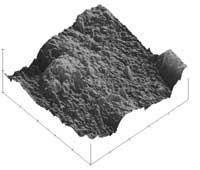Design of properties of thermorrigid matrices controlling the process of distribution of component phases
1998/06/01 Mondragon, Iñaki Iturria: Elhuyar aldizkaria
In recent years, but especially in the 1990s, new materials are being used in more and more applications. These new materials have allowed new developments. The current comfort has also come as follows: in aeronautics (faster and larger aircraft: For example, the Airbus project, in microelectronics (smaller chips), in automotive (more attractive cars), in medicine (prosthesis), in sports (tennis, golf, winter sports, boats, etc. ). ). It can be said that it is the “time of new materials”.
For the development of these new materials stand out the applications of thermoendoscopic polymers (epoxy, phenolic, cyanate, bismaleimide, etc. ): composite materials (combined with glass, carbon and other fibres), added, coatings, sandwiches, matrices at high temperature, etc. And the new uses are being worked day by day.
In a specific formulation for many new applications it is necessary to join several materials. From here comes the concept of “material design”. Because often the same material cannot meet all service requirements, other components (polymeric and others) are added to achieve what is necessary. However, to obtain quality and constant products, in addition to controlling the materials, it is necessary to know fully the process that is wanted to use (its kinetic and thermodynamic), since the resulting new product will depend on both. This is causing, among other reasons, the loss of ancient definitions: Science and Technology are fully unified in current developments.

In the case of thermorrigid matrices, the most serious problem is their fragility. With the aim of improving this aspect, research groups have addressed various transformations: the addition of caps, thermoplastics or predesigned particles (“core-shell”) for other very specific applications.
In this addition process we have two keys to obtain a product of excellent quality: the kinetics of the maturation process of the matrix (in the technology to be used) and the control of the thermodynamics of the distribution of phases between components. These two factors, as well as the concentration of components, must be fully controlled when designing the new product to be obtained and depend on these microstructures and morphologies of the matrix.
Our research group “Material + Technology” is working this way in the last ten years, among others. In the evolution of the project, in addition to the researchers of our group, other institutions have been of great help: University of Cranfield (England), Polytechnic University (New York), Engineering School of INTEMA-Mar del Plata (Argentina), etc. High level microscopic techniques (SEM, TEM, AFM) to carry out this type of research are absolutely necessary for the knowledge of the internal structure.
Transformations of epoxy and cyanate matrices in our laboratories have already been made with oligomers such as caps, thermoplastics (PMMA, PES, PEI, PC, etc.) and core-shell particles. Controlling the 2 keys mentioned at the top and using a single initial formulation, among other features, is working on designing a totally different product in terms of colors, mechanical and electrical properties. However, there is still a long way to go to create the general model of the “multimaterial” design, since each component has its own particularities.
Title of the project: Design of properties of thermorrigid matrices through the control of the process of distribution of component phases. Objective of the project:
Director: Iñaki Mondragon Working Team: P. P. Remiro, M. A. A. Corcuera, M. Franco, I. Harismendy, M. D. D. Martín, F.Mugika Department: Chemical and Environmental Engineering Center: Center: School of Industrial Engineering of San Sebastián |

Gai honi buruzko eduki gehiago
Elhuyarrek garatutako teknologia





